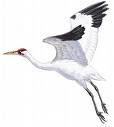
Until the end of April, impressive flocks of white and black storks, spoonbills, honey buzzards and even Pelicans can be seen soaring high in Israeli skies. Taking advantage of the updrafts produced when the wind blows over hills and mountain ridges, or making use of rising columns of warm air called ‘thermals’, they preserve precious energy by not having to flap their wings.
The longest of animal migrations are those of birds. Located at the junction of three continents, migrating birds use the little country of Israel on a scale unparalleled anywhere.

The sheer number of migrating birds that pass over Israel give the country a unique situation in the study of the phenomenon, which was, not surprisingly, noticed even in biblical times. The prophet Jeremiah (Jer. 7:8) tells the people that “Even the stork in the sky knows her appointed seasons, and the dove, the swift and the thrush observe the time of their migration….”
Studies have shown that about 500 million (!) birds cross Israel’s narrow airspace twice every year on their way to their African winter and European summer nesting grounds.

The magnitude and timing of the spring and autumn migrations of 35 species of medium-and-large sized raptors is just awesome. For some species, like the Lesser Spotted Eagle and Levant Sparrow hawk and the White Pelican, the whole world (!) population passes over Israel during migration, allowing an estimate of the world populations of these species.
Mean arrival dates of most raptors are highly predictable, and usually vary between 1.5 and 5.5 days, depending on the weather.
In the northern Galilee, the Hulah Valley’s newly created Lake Agmon has become a favourite and vital way station to stop, feed and rest on the long and exhausting journey. Each visitor to the Hulah Valley is deeply affected by the birds concentrated here.

Of course not everyone sees these birds in a positive light. When 25,000 cranes out of a population of 75,000 choose to spend their winters in the Hulah Valley, they attacked the fields of the local farmers.

In order to help both the farmers and the cranes, the Jewish National Fund stepped in with their so-called “Crane Project”. The birds were encouraged to feed at specific locations, while being chased from neighbouring crop fields. The program turned out to be such a success, that it became a model for other countries dealing with similar problems, including the US. Experts at the Hulah Valley not only collaborate on research with the US Forestry Service, but 22 additional countries as well.
Not only feeding these millions of birds is a challenge, but their massive migration also creates a safety problem for both the Israeli Air Force and the birds itself. Assisted by a radar and satellite, the Society for Protection of Nature in Israel, in cooperation with the Israel Air Force has been able to reduce the number of accidents by 88%.

During the spring and autumn migrations, bird observation centres are filled to overflowing with bird enthusiasts coming from all over the world.
Because birds don’t know any borders, they connect people from different countries, even those who are perceived to be Israel’s enemies.
When the flocks of storks, spoonbills, honey buzzards and Pelicans know it’s their season, they set out to soar, high in Israeli skies. Awed by the miracle of God’s creation, we may watch as these millions of birds return, year after year after year!

 Born on 12 May 1875, she planned to retire in 1939 but was reappointed a year later and continued until 1944.
Born on 12 May 1875, she planned to retire in 1939 but was reappointed a year later and continued until 1944.







